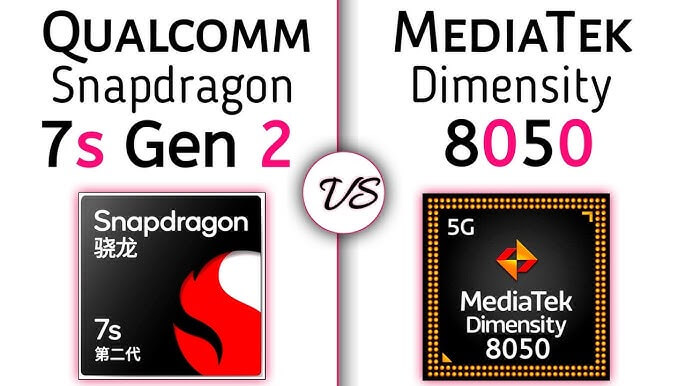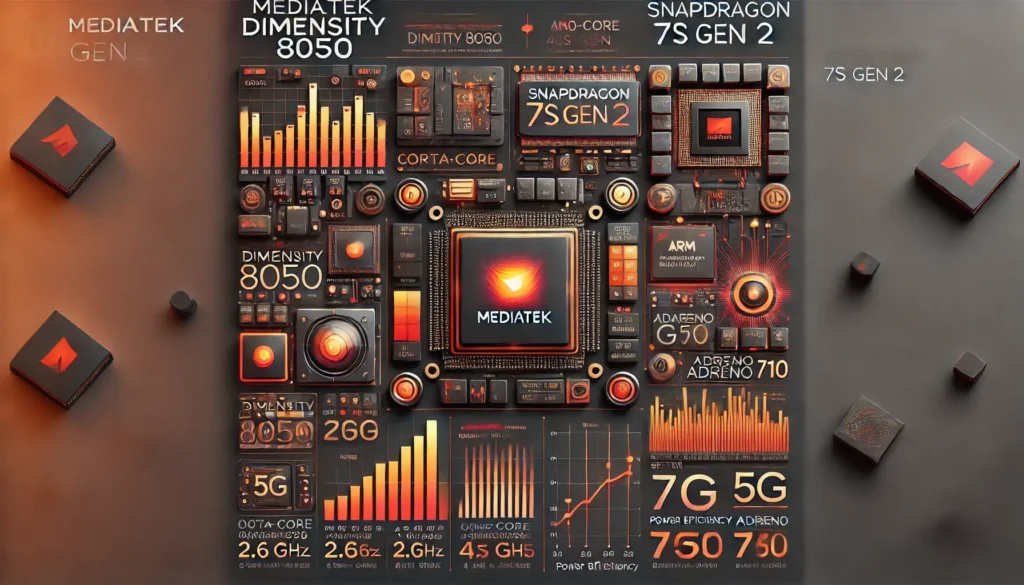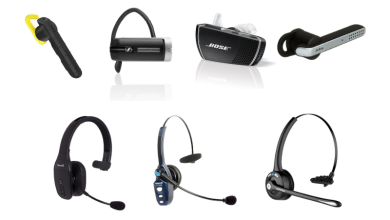MediaTek Dimensity 8050 vs Snapdragon 7s Gen 2 performance comparison

In the world of mobile processors, there have emerged two recent prominent names that will slug it out for dominance in the middle range of the market. They are MediaTek Dimensity 8050 and Qualcomm Snapdragon 7s Gen 2, respectively. While both are targeted at giving high performance to mid-tier smartphones, each chip tends to bring some unique advantages. This article will present a back-to-back comparison to help you understand how they stack against each other.
In The Article
Overview
The MediaTek Dimensity 8050 and Snapdragon 7s Gen 2 are targeted to achieve an efficient balance between performance and power efficiency. This chip belongs to users who would have flagship-like experiences sans the premium price tags. From constant gaming, extreme multitasking, to all other power- and AI-driven tasks, both processors promise to handle the rigors that come with modern smartphone use.
Here’s the infographic comparing the MediaTek Dimensity 8050 and Snapdragon 7s Gen 2 chipsets. You can now visualize their performance comparison across CPU, GPU, power efficiency, and other aspects.

Specifications Overview
| Processor | MediaTek Dimensity 8050 | Snapdragon 7s Gen 2 |
|---|---|---|
| Fabrication Process | 6nm | 4nm |
| CPU Architecture | Octa-core (1x Cortex-A78 @ 3.0 GHz, 3x Cortex-A78 @ 2.6 GHz, 4x Cortex-A55 @ 2.0 GHz) | Octa-core (4x Cortex-A78 @ 2.4 GHz, 4x Cortex-A55 @ 1.9 GHz) |
| GPU | Mali-G77 MC9 | Adreno 710 |
| AI Engine | MediaTek APU 3.0 | Qualcomm AI Engine |
| 5G Support | Yes | Yes |
| Display Support | 120Hz refresh rate | 120Hz refresh rate |
| RAM Support | LPDDR4x / LPDDR5 | LPDDR5 |
| Storage Support | UFS 3.1 | UFS 3.1 |
CPU Performance
The CPU is the heart of any processor, and both the Dimensity 8050 and Snapdragon 7s Gen 2 are fitted with capable cores. The MediaTek Dimensity 8050 uses a 1+3+4 architecture in which there is a single high-performance Cortex-A78 core that runs at as high as 3.0 GHz for heavy tasks, while three more Cortex-A78 cores are available at 2.6 GHz and four efficiency cores based on the Cortex-A55 at 2.0 GHz.
In contrast, Snapdragon 7s Gen 2 follows the 4+4 configuration: four Cortex-A78 cores running at 2.4 GHz and four Cortex-A55 cores running at 1.9 GHz. While the Dimensity 8050 has a higher maximum clock speed on its primary core, the Snapdragon offers better balanced multi-core performance owing to the equal divide between high and low-power cores.
Verdict: If single-core performance is considered the priority, then Dimensity 8050 leads the way, whereas in consistent multi-thread loads, the Snapdragon 7s Gen 2 might be marginally better because of its even distribution of cores.
GPU and Gaming Performance
In benchmark tests from GSMArena, the Snapdragon 7s Gen 2 outperformed the Dimensity 8050 in graphics-heavy games, particularly due to its superior Adreno 710 GPU.
The GPU plays a very important role in gaming to maintain smooth rendering of graphics and a high frame rate. The MediaTek Dimensity 8050 is powered by a Mali-G77 MC9 GPU, known to handle HQ graphic elements with ease without power consumption. On the other hand, Qualcomm’s Adreno 710 GPU inside the Snapdragon 7s Gen 2 has been optimized for better performance in gaming and 3D rendering.
In practical use, both GPUs are capable of running popular games like PUBG Mobile, Genshin Impact, and Call of Duty: Mobile at high settings with stable frame rates. However, traditionally, Qualcomm’s Adreno series has been more favored among gamers due to better optimization for major game engines.
Verdict: The Adreno 710 in the Snapdragon 7s Gen 2 will most probably outperform the Mali-G77 MC9 for hardcore gamers by offering smoother performance in more graphically demanding games.
AI and Machine Learning Capabilities
AI-driven features have been finding increasing prominence on smartphones. Be it improving camera quality using computational photography, refining voice recognition, or boosting battery life using smart power management, AI serves as the linchpin of modern smartphones.
The MediaTek Dimensity 8050 boasts the MediaTek APU 3.0, a dedicated AI processing unit that excels in tasks such as AI-based image processing, **voice commands, or *video upscaling*. It is capable of dealing with real-time enhancements while capturing photos and videos, making it ideal for camera-centric smartphones.
In the Snapdragon 7s Gen 2, it also has Qualcomm’s AI Engine, which is supposed to also do solid work in machine learning tasks. What Snapdragon truly excels at with AI capabilities is in voice assistants, contextual awareness, and gaming experience enhancement because of dynamic optimization.
Verdict: Both chips put on a good show in AI tasks, but the MediaTek Dimensity 8050 may hold a slight advantage when it comes to camera-centric AI features.
Connectivity and 5G Support
But of course, it has the 5G modem, and so does the Snapdragon 7s Gen 2-both provide quite fast download and upload speeds over next-gen networks. They feature sub-6GHz 5G, which is the most available version of 5G worldwide.
About the rest of the connectivity features, both support Wi-Fi 6, Bluetooth 5.2, and dual SIM 5G. With such features, one can have fast wireless communication and can easily run all the modern applications that require cloud gaming and HD video streaming on your phone smoothly.
Verdict: This round is a tie in the sense that both chipsets offer top-notch 5G and wireless performance.
Power Efficiency and Battery Life
Battery life is a big concern for end-users, and both chipsets have been designed keeping power efficiency in mind. The MediaTek Dimensity 8050 is fabricated using a 6nm process, which is energy-efficient but a tad less advanced compared to the 4nm process used by Qualcomm in the **Snapdragon 7s Gen 2.
This more advanced fabrication process is what the Snapdragon 7s Gen 2 benefits from, promising better power efficiency, especially when at idle or during low use. Qualcomm’s AI-driven battery management plays its role in extending the battery life by intelligently handling background processes.
Verdict: The Snapdragon 7s Gen 2, with its more advanced 4nm fabrication, might have better battery efficiency compared to the 6nm Dimensity 8050, but real-world differences will depend heavily on optimization by smartphone manufacturers.
Camera and Imaging
One of the key features both the processors are made to support is high-quality imaging experiences. The MediaTek Dimensity 8050 supports up to 4K video recording and up to 108MP camera sensors. Besides this, its AI-powered enhancements improve low-light photography, reduce noise, and further enhance HDR performance.
It also enables 4K HDR video recording and offers support for cameras up to 200MP, ideal for multi-camera smartphones. In general, the image processing capabilities of Qualcomm’s Spectra ISP are considered better, offering superior dynamic range and more detailed low-light performance.
Verdict: This is where the Snapdragon 7s Gen 2 is expected to take the lead because it can support a higher resolution sensor and does so with the robust ISP technology of Qualcomm.
Price and Availability
Lower-end mid-range devices boast a number of Media Tek Dimensity 8050 processors. One will notice that these achieve a very good performance at relatively cheaper prices. Phones with Snapdragon 7s Gen 2 tend to be more pricey due to Qualcomm’s brand name and advanced features on the chip.
Verdict: If looking from the cost-effective perspective, smartphones having Dimensity 8050 should be a better value, but if someone is willing to pay a little more for probably superior performance and future-proofing, the Snapdragon 7s Gen 2 is the way to go.
Conclusion
Both MediaTek Dimensity 8050 and Snapdragon 7s Gen 2 are very good processors that feature in mid-range smartphones, promising enough to provide solid performance with AI capabilities and 5G support. Specifically, Dimensity 8050 does exceptionally well in single-core CPU performance and pricing, while Snapdragon 7s Gen 2 surpasses it in gaming, AI, and power efficiency.
Ultimately, these two are going to come down to your needs: for a gamer or power user, the Snapdragon 7s Gen 2 is possibly better, but the MediaTek Dimensity 8050 has incredible value for the overall user, seeking balance between performance and cost.
Sources:
- GSMArena – Smartphone Processor Comparisons
GSMArena
Benchmark comparisons and performance data for Snapdragon 7s Gen 2 and MediaTek Dimensity 8050. - AnTuTu Benchmark – Mobile Chipset Performance Rankings
AnTuTu Benchmark
Source for benchmark performance scores for mobile processors. - Android Authority – Chipset Reviews and Comparisons
Android Authority
In-depth review and comparison of mobile processors, including Snapdragon 7s Gen 2 and MediaTek Dimensity 8050. - TechRadar – Mobile Processor Analysis
TechRadar
Reviews and analysis of mid-range mobile chipsets with performance comparisons.




